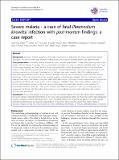Files in this item
Severe malaria - a case of fatal Plasmodium knowlesi infection with post-mortem findings : a case report
Item metadata
| dc.contributor.author | Cox Singh, Janet | |
| dc.contributor.author | Hiu, Jessie | |
| dc.contributor.author | Lucas, Sebastian B. | |
| dc.contributor.author | Divis, Paul C. | |
| dc.contributor.author | Zulkarnaen, Mohammad | |
| dc.contributor.author | Chandran, Patricia | |
| dc.contributor.author | Wong, Kum T. | |
| dc.contributor.author | Adem, Patricia | |
| dc.contributor.author | Zaki, Sherif R. | |
| dc.contributor.author | Singh, Balbir | |
| dc.contributor.author | Krishna, Sanjeev | |
| dc.date.accessioned | 2013-07-24T15:31:01Z | |
| dc.date.available | 2013-07-24T15:31:01Z | |
| dc.date.issued | 2010-01-11 | |
| dc.identifier | 23165740 | |
| dc.identifier | e8902286-6cfa-4dc4-a5dc-4acf33839f62 | |
| dc.identifier | 000274379500001 | |
| dc.identifier | 76749159996 | |
| dc.identifier.citation | Cox Singh , J , Hiu , J , Lucas , S B , Divis , P C , Zulkarnaen , M , Chandran , P , Wong , K T , Adem , P , Zaki , S R , Singh , B & Krishna , S 2010 , ' Severe malaria - a case of fatal Plasmodium knowlesi infection with post-mortem findings : a case report ' , Malaria Journal , vol. 9 , 10 . https://doi.org/10.1186/1475-2875-9-10 | en |
| dc.identifier.issn | 1475-2875 | |
| dc.identifier.other | ORCID: /0000-0003-4878-5188/work/64034457 | |
| dc.identifier.uri | https://hdl.handle.net/10023/3871 | |
| dc.description.abstract | Background: Zoonotic malaria caused by Plasmodium knowlesi is an important, but newly recognized, human pathogen. For the first time, post-mortem findings from a fatal case of knowlesi malaria are reported here. Case presentation: A formerly healthy 40 year-old male became symptomatic 10 days after spending time in the jungle of North Borneo. Four days later, he presented to hospital in a state of collapse and died within two hours. He was hyponatraemic and had elevated blood urea, potassium, lactate dehydrogenase and amino transferase values; he was also thrombocytopenic and eosinophilic. Dengue haemorrhagic shock was suspected and a postmortem examination performed. Investigations for dengue virus were negative. Blood for malaria parasites indicated hyperparasitaemia and single species P. knowlesi infection was confirmed by nested-PCR. Macroscopic pathology of the brain and endocardium showed multiple petechial haemorrhages, the liver and spleen were enlarged and lungs had features consistent with ARDS. Microscopic pathology showed sequestration of pigmented parasitized red blood cells in the vessels of the cerebrum, cerebellum, heart and kidney without evidence of chronic inflammatory reaction in the brain or any other organ examined. Brain sections were negative for intracellular adhesion molecule-1. The spleen and liver had abundant pigment containing macrophages and parasitized red blood cells. The kidney had evidence of acute tubular necrosis and endothelial cells in heart sections were prominent. Conclusions: The overall picture in this case was one of systemic malaria infection that fit the WHO classification for severe malaria. Post-mortem findings in this case were unexpectedly similar to those that define fatal falciparum malaria, including cerebral pathology. There were important differences including the absence of coma despite petechial haemorrhages and parasite sequestration in the brain. These results suggest that further study of knowlesi malaria will aid the interpretation of, often conflicting, information on malaria pathophysiology in humans. | |
| dc.format.extent | 7 | |
| dc.format.extent | 371642 | |
| dc.language.iso | eng | |
| dc.relation.ispartof | Malaria Journal | en |
| dc.subject | RB Pathology | en |
| dc.subject | SDG 3 - Good Health and Well-being | en |
| dc.subject.lcc | RB | en |
| dc.title | Severe malaria - a case of fatal Plasmodium knowlesi infection with post-mortem findings : a case report | en |
| dc.type | Journal article | en |
| dc.contributor.institution | University of St Andrews. School of Medicine | en |
| dc.contributor.institution | University of St Andrews. Infection Group | en |
| dc.contributor.institution | University of St Andrews. Biomedical Sciences Research Complex | en |
| dc.identifier.doi | 10.1186/1475-2875-9-10 | |
| dc.description.status | Peer reviewed | en |
| dc.identifier.url | http://www.malariajournal.com/content/9/1/10 | en |
This item appears in the following Collection(s)
Items in the St Andrews Research Repository are protected by copyright, with all rights reserved, unless otherwise indicated.

